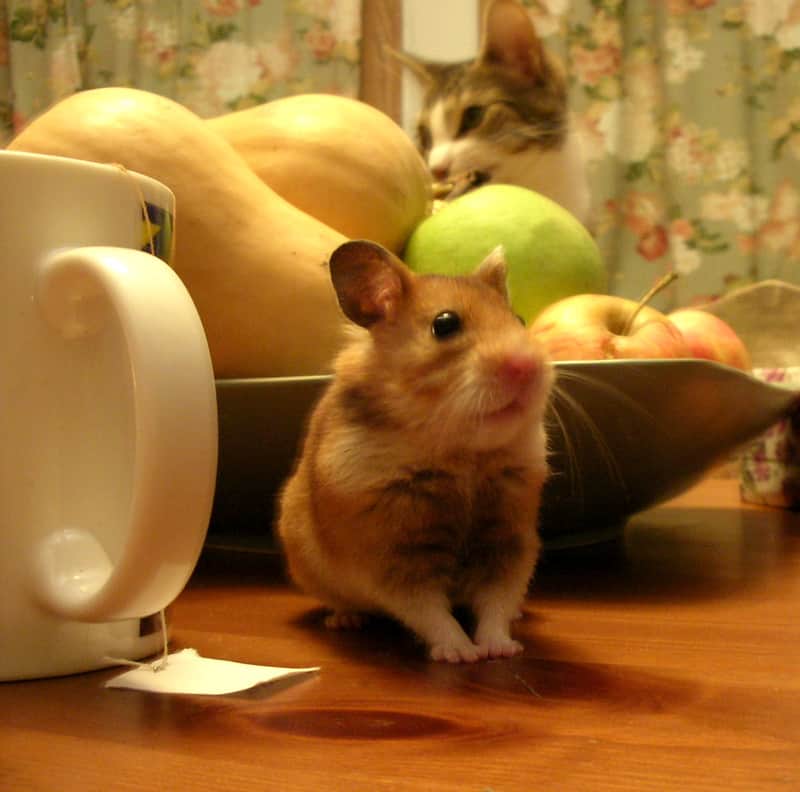For many pet owners, the idea of keeping a hamster and a cat together in the same household might seem like a daunting task. After all, hamsters are typically small, delicate creatures, while cats are known for their predatory instincts. However, with proper planning and precautions, it is possible to keep these two pets together and create a happy, harmonious home.
In this comprehensive guide, we’ll explore everything you need to know about keeping a hamster and a cat together. We’ll cover the challenges, best practices, and safety tips to make sure that both pets are healthy and happy. So let’s dive in!

Understanding Your Pets
Before we get into the specifics of keeping a hamster and a cat together, it’s important to understand the behavior and habits of both pets. This will help you better anticipate potential issues and address them before they become a problem.
Hamsters are typically nocturnal creatures, meaning they are most active at night. They are also solitary animals, so they prefer to live alone in their own cage or habitat. Hamsters are very sensitive to stress, so it’s important to provide them with plenty of hiding places and a quiet, calm environment.
Cats, on the other hand, are social animals that can be active both during the day and night. They are natural hunters and have a strong prey drive, which means that they may see a small animal like a hamster as an opportunity to hunt.
When introducing a hamster to a cat, it’s important to do so gradually and under close supervision. Start by keeping the two pets in separate rooms and gradually allow them to spend short periods of time together (while the hamster remains in its cage). Watch for any signs of aggression or stress in either pet, and be prepared to separate them if necessary.
It is important to mention that your hamster will be able to smell that you have a cat and vice versa. Both cats and hamsters have a keen sense of smell. As a result, it’s very likely that your hamster will be more stressed than usual, at least initially. Over time, it might learn that the scent of the cat does not pose a threat to them.
Setting Up Your Home
To keep a hamster and a cat together, you’ll need to create a safe environment for both pets. This means choosing the right cages or habitats and making sure that the cat cannot access the hamster’s cage.
For hamsters, a wire cage with a solid bottom is ideal. Make sure the cage is large enough for the hamster to move around comfortably and includes plenty of hiding places and toys. For cats, make sure they have their own space to retreat to, such as a cat tree or bed.
To keep the cat away from the hamster’s cage, you can try placing the cage on a high shelf or table that the cat cannot access. You can also use baby gates or other barriers to create a separate area for the hamster.
Supervision and Safety Tips
When the hamster and cat are together, it’s important to supervise their interactions closely. Make sure that the cat is not showing any signs of aggression or stress, and that the hamster has plenty of hiding places to retreat to if necessary.
If there is an altercation between the pets, separate them immediately and assess any injuries. If necessary, seek veterinary care for either pet.
You can also teach your cat to respect the hamster’s space by providing positive reinforcement when they are calm and relaxed around the hamster. You can also try using deterrents, such as a spray bottle or loud noise, to discourage the cat from approaching the hamster’s cage.
Conclusion
Keeping a hamster and a cat together can be a rewarding experience for pet owners, but it requires careful planning and consideration. By understanding the behavior of both pets, creating a safe environment, and providing proper care and supervision, you can create a happy home for both pets.
However, it’s important to remember that not all cats and hamsters will get along. If you notice any signs of aggression or stress in either pet, it may be best to keep them separate for their own safety.
Overall, the key to success is to be patient, observant, and willing to make adjustments as necessary. With the right preparation and care, you can create a happy and harmonious home for your furry friends.
- How Long Do American Eskimo Dogs Live? Important Factors and Care Tips - September 29, 2023
- Do American Bulldogs Need Grooming? Essential Tips and Care Guidelines - September 29, 2023
- Do Bengal Cats Enjoy Playing? Essential Tips for Keeping Them Active - September 29, 2023